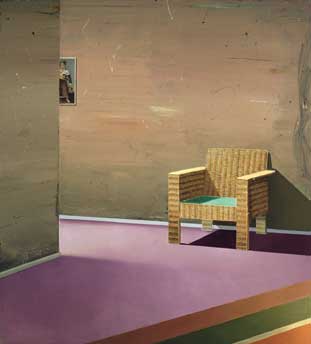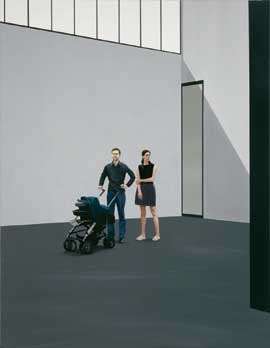Peeler Center Presents 'Life After Death: New Leipzig Paintings from the Rubell Family Collection'
March 15, 2008
Also: 'Zoe Strauss: Works in Progress,' March 12 - April 13
 March 15, 2008, Greencastle, Ind. - DePauw University presents "Life After Death: New Leipzig Paintings from the Rubell Family Collection," an exhibition that presents the foremost U.S. collection of paintings from the New Leipzig School. The works will be on view at DePauw's Richard E. Peeler Art Center from March 19 through May 18. The exhibition is free and open to the public. (at left: Neo Rauch, Demos (Demonstrations), 2004; oil on canvas, courtesy of the Rubell Family Collection)
March 15, 2008, Greencastle, Ind. - DePauw University presents "Life After Death: New Leipzig Paintings from the Rubell Family Collection," an exhibition that presents the foremost U.S. collection of paintings from the New Leipzig School. The works will be on view at DePauw's Richard E. Peeler Art Center from March 19 through May 18. The exhibition is free and open to the public. (at left: Neo Rauch, Demos (Demonstrations), 2004; oil on canvas, courtesy of the Rubell Family Collection)
In December 2000, a group of five young German artists, all recent graduates of the prestigious Leipzig Art Academy, organized a small exhibition of their works in Leipzig. Unsurprisingly, the exhibition attracted no notice from the international contemporary art community. From that humble beginning, the "New Leipzig School" has expanded to a dozen artists and has grown to be an international phenomenon -- its painters making work that has museums and collectors in its thrall. (at right: Matthias Weischer, Stuhl (Chair), 2003; oil on canvas, courtesy of the Rubell Family Collection)
These painters breathe new life into the East German tradition of social realist figure painting with enigmatic narratives and surrealist overtones. The New Leipzig School is the 21st century's first bona fide artistic phenomenon. In addition to their affiliation with the Leipzig Art Academy, the New Leipzig School painters share stylistic concerns, which are shaped in part by the tradition of the school and East German social realism more generally. A strange surrealism and a discordant palette pervade their interiors, cityscapes, and landscapes, which are often populated by disaffected figures. A general feeling of world-weariness and ennui speaks to the East German political situation -- these are depictions of places and people that are not prepared to integrate into the brand-new optimistic West. Unready to face the new, they are nostalgic for the old, but more from habit than any affection.
The Leipzig Academy, founded in 1764, is one of the oldest art schools in Germany. It is highly regarded for its tradition of figure painting, which, before the reunification of Germany in 1989-90, was bound to state-mandated "social-realist" painting. While academies in the West eschewed figurative painting, and sometimes painting itself, in favor of abstraction and work in new media, the Leipzig Academy produced some of East Germany's most highly regarded figure painters.
The undeniable buzz that surrounds the New Leipzig School is due in part to the enthusiasm that collectors Mera and Don Rubell have shown for their work. Always bellwethers, the Rubells first visited Liga, the Leipzig gallery that these artists maintained between March 2002 and April 2004, in its inaugural year. They began acquiring their work immediately and have continued to support many of the artists. (at left: Tim Eitel, Leerer Raum (Empty Room), 2004; oil and acrylic on canvas, courtesy of the Rubell Family Collection)
Housed in a nondescript 45,000-square-foot Miami warehouse that once served as a Drug Enforcement Administration storage facility, the Rubell Family Art Collection features some of the edgiest and most important contemporary work of the last 40 years. The collection, which contains 6000 pieces by celebrated artists including Keith Haring, Peter Halley, Damien Hirst, David Salle, and Cindy Sherman, is a representation of every major influence in contemporary art over the last three decades. It includes paintings, sculptures, drawings, photographs, installation, and videos.
Minimalism, neo-expressionism, neo-geo, photography, and identity politics are the art movements best exemplified by the body of work the Rubells -- father Don, mother Mera, and children Jennifer and Jason -- have lovingly assembled by seeking out the small studios of emerging but undiscovered artists in the U.S., Europe, Africa, Asia, and Latin America.
"Life After Death" is co-curated by Mark Coetzee, director of the Rubell Family Collection, Miami, and Laura Steward  Heon, director and curator of SITE Santa Fe. Its presentation at DePauw has been made possible by the generous support of Neal Abraham, Donna Wiley, and an anonymous donor.
Heon, director and curator of SITE Santa Fe. Its presentation at DePauw has been made possible by the generous support of Neal Abraham, Donna Wiley, and an anonymous donor.
The galleries at the Richard E. Peeler Art Center are open Tuesday through Friday from 10 a.m. to 4 p.m.; Saturday 11 a.m. - 5 p.m.; and Sunday 1 - 5 p.m., and are closed during University breaks and holidays.
For more information, visit the Peeler Art Center online.
Back